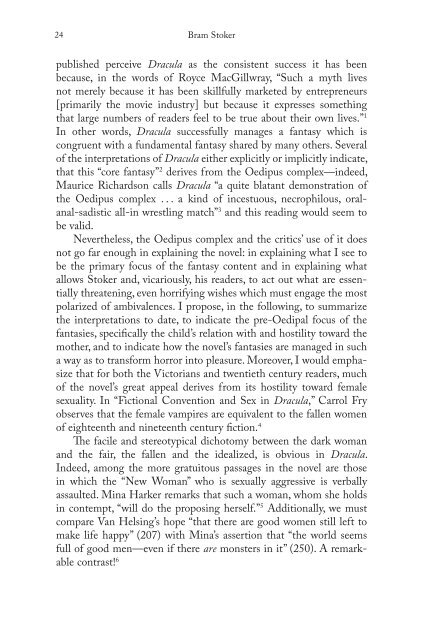Bloom's Literary Themes - ymerleksi - home
Bloom's Literary Themes - ymerleksi - home
Bloom's Literary Themes - ymerleksi - home
You also want an ePaper? Increase the reach of your titles
YUMPU automatically turns print PDFs into web optimized ePapers that Google loves.
24<br />
Bram Stoker<br />
published perceive Dracula as the consistent success it has been<br />
because, in the words of Royce MacGillwray, “Such a myth lives<br />
not merely because it has been skillfully marketed by entrepreneurs<br />
[primarily the movie industry] but because it expresses something<br />
that large numbers of readers feel to be true about their own lives.” 1<br />
In other words, Dracula successfully manages a fantasy which is<br />
congruent with a fundamental fantasy shared by many others. Several<br />
of the interpretations of Dracula either explicitly or implicitly indicate,<br />
that this “core fantasy” 2 derives from the Oedipus complex—indeed,<br />
Maurice Richardson calls Dracula “a quite blatant demonstration of<br />
the Oedipus complex . . . a kind of incestuous, necrophilous, oralanal-sadistic<br />
all-in wrestling match” 3 and this reading would seem to<br />
be valid.<br />
Nevertheless, the Oedipus complex and the critics’ use of it does<br />
not go far enough in explaining the novel: in explaining what I see to<br />
be the primary focus of the fantasy content and in explaining what<br />
allows Stoker and, vicariously, his readers, to act out what are essentially<br />
threatening, even horrifying wishes which must engage the most<br />
polarized of ambivalences. I propose, in the following, to summarize<br />
the interpretations to date, to indicate the pre-Oedipal focus of the<br />
fantasies, specifically the child’s relation with and hostility toward the<br />
mother, and to indicate how the novel’s fantasies are managed in such<br />
a way as to transform horror into pleasure. Moreover, I would emphasize<br />
that for both the Victorians and twentieth century readers, much<br />
of the novel’s great appeal derives from its hostility toward female<br />
sexuality. In “Fictional Convention and Sex in Dracula,” Carrol Fry<br />
observes that the female vampires are equivalent to the fallen women<br />
of eighteenth and nineteenth century fiction. 4<br />
The facile and stereotypical dichotomy between the dark woman<br />
and the fair, the fallen and the idealized, is obvious in Dracula.<br />
Indeed, among the more gratuitous passages in the novel are those<br />
in which the “New Woman” who is sexually aggressive is verbally<br />
assaulted. Mina Harker remarks that such a woman, whom she holds<br />
in contempt, “will do the proposing herself.” 5 Additionally, we must<br />
compare Van Helsing’s hope “that there are good women still left to<br />
make life happy” (207) with Mina’s assertion that “the world seems<br />
full of good men—even if there are monsters in it” (250). A remarkable<br />
contrast! 6
















